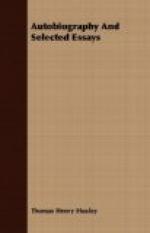[Footnote 55: Poll: an abbreviation and transliteration of [Footnote Greek words], “the mob”; university slang for the whole body of students taking merely the degree of Bachelor of Arts, at Cambridge.]
[Footnote 56: pluck: the rejection of a student, after examinations, who does not come up to the standard.]
ON A PIECE OF CHALK
[Footnote 57: On a Piece of Chalk: a lecture to working-men from Lay Sermons, Addresses and Reviews.]
[Footnote 58: Needles of the Isle of Wight: the needles are three white, pointed rocks of chalk, resting on dark-colored bases, and rising abruptly from the sea to a height of 100 feet. Baedeker’s Great Britain.]
[Footnote 59: Lulworth in Dorset, to Flamborough Head: Lulworth is on the southern coast of England, west of the Isle of Wight: Flamborough Head is on the northeastern coast of England and extends into the German Ocean.]
[Footnote 60: Weald: a name given to an oval-shaped chalk area in England, beginning near the Straits of Dover, and extending into the counties of Kent, Surrey, Hants, and Sussex.]
[Footnote 61: Lieut. Brooke: Brooke devised an apparatus for deep-sea sounding from which the weight necessary to sink the instrument rapidly, was detached when it reached the bottom. The object was to relieve the strain on the rope caused by rapid soundings. Improved apparatuses have been invented since the time of Brooke.]
[Footnote 62: Ehrenberg (1795-1876): a German naturalist noted for his studies of Infusoria.]
[Footnote 63: Bailey of West Point (1811-1857): an American naturalist noted for his researches in microscopy.]
[Footnote 64: enterprise of laying down the telegraph-cable: the first Atlantic telegraph-cable between England and America was laid in 1858 by Cyrus W. Field of New York. Messages were sent over it for a few weeks; then it ceased to act. A permanent cable was laid by Mr. Field in 1866.]
[Footnote 65: Dr. Wallich (1786-1854): a Danish botanist and member of the Royal Society.]
[Footnote 66: Mr. Sorby: President of the Geological Society of England, and author of many papers on subjects connected with physical geography.]
[Footnote 67: Sir Charles Lyell (1797-1875): a British geologist, and one of the first to uphold Darwin’s Origin of Species.]
[Footnote 68: Echinus: the sea-urchin; an animal which dwells in a spheroidal shell built up from polygonal plates, and covered with sharp spines.]
[Footnote 69: Somme: a river of northern France which flows into the English Channel northeast of Dieppe.]
[Footnote 70: the chipped flints of Hoxne and Amiens: the rude instruments which were made by primitive man were of chipped flint. Numerous discoveries of large flint implements have been made in the north of France, near Amiens, and in England. The first noted flint implements were discovered in Hoxne, Suffolk, England, 1797. Cf. Evans’ Ancient Stone Implements and Lyell’s Antiquity of Man.]




